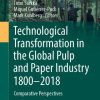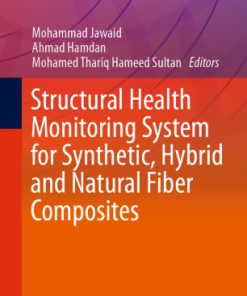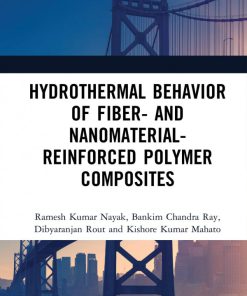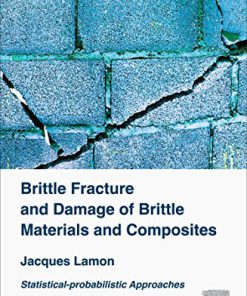Modelling of Damage Processes in Biocomposites Fibre Reinforced Composites and Hybrid Composites 1st Edition by Mohammad Jawaid, Mohamed Thariq, Naheed Saba ISBN 9780081022979 0081022972
$50.00 Original price was: $50.00.$25.00Current price is: $25.00.
Modelling of Damage Processes in Biocomposites Fibre Reinforced Composites and Hybrid Composites 1st Edition by Mohammad Jawaid, Mohamed Thariq, Naheed Saba – Ebook PDF Instant Download/Delivery: 9780081022979 ,0081022972
Full download Modelling of Damage Processes in Biocomposites Fibre Reinforced Composites and Hybrid Composites 1st Edition after payment
Product details:
ISBN 10: 0081022972
ISBN 13: 9780081022979
Author: Mohammad Jawaid, Mohamed Thariq, Naheed Saba
Modelling of Damage Processes in Biocomposites, Fibre-Reinforced Composites and Hybrid Composites focuses on the advanced characterization techniques used for the analysis of composite materials developed from natural fiber/biomass, synthetic fibers and a combination of these materials used as fillers and reinforcements to enhance materials performance and utilization in automotive, aerospace, construction and building components. It will act as a detailed reference resource to encourage future research in natural fiber and hybrid composite materials, an area much in demand due to the need for more sustainable, recyclable, and eco-friendly composites in a broad range of applications.
Written by leading experts in the field, and covering composite materials developed from different natural fibers and their hybridization with synthetic fibers, the book’s chapters provide cutting-edge, up-to-date research on the characterization, analysis and modelling of composite materials.
- Contains contributions from leading experts in the field
- Discusses recent progress on failure analysis, SHM, durability, life prediction and the modelling of damage in natural fiber-based composite materials
- Covers experimental, analytical and numerical analysis
- Provides detailed and comprehensive information on mechanical properties, testing methods and modelling techniques
Modelling of Damage Processes in Biocomposites Fibre Reinforced Composites and Hybrid Composites 1st Edition Table of contents:
1 – Finite element modeling of natural fiber-based hybrid composites
1.1 Introduction
1.1.1 Natural fibers (or cellulose-based fibers)
1.1.1.1 Mechanical properties
1.1.1.2 Chemical composition
1.1.2 Composite materials
1.1.3 Hybrid composites
1.2 Micromechanical material modeling
1.3 Finite element formulations
1.3.1 Displacement field
1.3.2 Strain–displacement relation
1.3.3 Constitutive relations
1.3.4 Governing equation
1.4 Finite element solutions of natural fiber-based hybrid composites
1.5 Conclusions
References
2 – The effects of cut-out on thin-walled plates
2.1 Introduction
2.2 Finite element analysis
2.2.1 Analytical model
2.2.2 Material model and boundary conditions
2.2.3 Element selection
2.2.4 Convergence test
2.3 Analysis of results
2.3.1 Shear buckling behavior of perforated square plates
2.3.2 Shear buckling behavior of rectangular perforated plates
3 – Modeling of crushing mechanisms of hybrid metal/fiber composite cylindrical tubes
3.1 Introduction
3.2 Research methodology
3.3 Results and discussion
3.3.1 Effect of oblique compression angles on the force–displacement curves for empty tubes
3.3.2 Effect of oblique angles on the specific energy absorption capability
3.3.3 Effect of tube aspect ratios on the crushing performance
3.3.4 Effect of materials, fiber orientations, and oblique compression angles on the crushing perfor
3.4 Conclusion
Acknowledgments
References
4 – Roles of layers and fiber orientations on the mechanical durability of hybrid composites
4.1 Introduction
4.2 Methodology
4.3 Results and discussion
4.4 Conclusion
References
Further reading
5 – Numerical modeling of hybrid composite materials
5.1 Introduction
5.2 Classification of materials and filler types
5.2.1 Matrix
5.2.2 Reinforcements
5.2.2.1 Fiber reinforcements
5.2.2.2 Particulate reinforcements
5.2.2.3 Flake reinforcements
5.2.2.4 Hybrid composite materials (more than one element of distinct reinforcements)
5.3 Various modeling techniques of composite mechanical properties
5.3.1 Goal
5.3.2 Mechanics of composites
5.3.2.1 Micromechanical analysis
5.3.2.2 Macromechanical analysis
Representation
Location
Situation with homogeneous deformation
Situation with homogeneous stress
Homogenization
5.3.2.3 Bounding models
One-point bounds
Voigt model
Reuss model
Voigt–Reuss–Hill average
Two-point bounds
Hashin and Shtrikman model
5.3.2.4 Semiempirical models
Modified rule-of-mixture
Halpin–Tsai’s method
Hirsch’s method
5.3.2.5 Homogenization models
Tsai–Pagano’s method
Eshelby’s method
Inclusion problem
Intuitive approach
Equivalent inclusion method
Mori–Tanaka model
5.4 Numerical modeling of the mechanical behavior of composite material
5.4.1 Finite difference method
5.4.2 Finite element method
5.4.3 Boundary element method
5.5 Numerical modeling of hybrid composite materials
5.5.1 Fiber hybridization
5.5.2 Hybrid particulate fiber-reinforced composites
5.5.2.1 Representative volume element
5.5.2.2 Representative unit cell
5.5.2.3 Object-oriented modeling
5.6 Conclusion
Acknowledgments
References
6 – Computationally efficient modeling of woven composites under uniaxial stress
6.1 Introduction
6.2 Material
6.3 Finite element modeling
6.3.1 Finite element model
6.3.2 Boundary conditions and pretension technique
6.3.3 Interaction in modeling
6.4 Mesh sensitivity analysis
6.4.1 Mesh sensitivity study impact of a flat projectile
6.4.2 Ballistic limit prediction of hemispherical projectile using FE simulation
6.5 Conclusions
Acknowledgments
References
7 – Progressive damage modeling of synthetic fiber polymer composites under ballistic impact
7.1 Introduction
7.2 Material properties of carbon fiber-reinforced plastic
7.3 Finite element modeling using the continuum shell element
7.3.1 Progressive damage modeling
7.3.2 Finite element model
7.3.3 Boundary conditions and pretension technique
7.3.4 Interaction in modeling
7.3.5 Mesh sensitivity analysis
7.4 Results and discussion
7.4.1 Ballistic limit prediction of hemispherical projectile using finite element simulation
7.4.2 Ballistic limit finite element against experimental results
7.4.3 Failure modes of a CFRP target after impact
7.4.4 Damage assessment from simulation and experiment
7.4.5 Impact force
7.5 Conclusions
Acknowledgments
References
8 – Investigation of damage processes of a microencapsulated self-healing mechanism in glass fiber-r
8.1 Introduction
8.2 Chemistry of capsule-based self-healing materials
8.3 Background to the study
8.4 Fabrication process
8.4.1 Fabricating microcapsules
8.4.2 Fabricating self-healing GFRP
8.5 Experimental plan
8.6 Testing
8.6.1 Static mechanical properties
8.6.2 Dynamic mechanical properties
8.7 Study of the effect of a self-healing agent on mechanical properties
8.7.1 Effect of factors on tensile strength
8.7.2 Effect of factors on compressive strength
8.7.3 Effect of factors on flexural strength
8.7.4 Effect of factors on in-plane shear strength
8.8 Study of the effect of self-healing agent on dynamic mechanical properties
8.9 Microstructural analysis
8.10 Discussion and conclusion
References
9 – Finite element analysis of natural fiber-reinforced polymer composites
9.1 Introduction
9.2 Basic steps in finite element analysis
9.2.1 Preprocessing
9.2.2 Solving
9.2.3 Postprocessing
9.2.4 Convergence in finite element analysis
9.3 Finite element analysis of polymer matrix composites
9.3.1 Significance of material characterization of composites in finite element analysis
9.4 An overview of finite element analysis of natural fiber-reinforced polymer composites
9.4.1 Finite element modeling
9.4.1.1 Analysis type
9.4.1.2 Part modeling
9.4.1.3 Material modeling
9.4.1.4 Material properties
9.4.1.5 Meshing
9.4.1.6 Boundary conditions
9.4.1.7 Loading
9.4.1.8 Solving
9.4.1.9 Extraction of results
9.4.1.10 Outcome of finite element analysis results
9.5 Finite element analysis of natural fiber and natural fiber-reinforced polymer composites
9.5.1 Finite element models of different natural fibers
9.5.1.1 Macromechanical analysis
9.5.1.2 Micromechanical analysis
9.5.1.3 Mesoscale representative volume element models
9.5.2 Finite element analysis of natural fiber-reinforced polymer composites
9.5.2.1 Thermal analysis of natural fiber-reinforced polymer composites
9.5.2.2 Mechanical analysis of natural fiber-reinforced polymer composite
Micromechanics models for stiffness prediction
Assumptions and limitations
9.5.2.3 Representative volume element modeling and analysis of natural fiber-reinforced polymer comp
9.5.3 Failure modeling of natural fiber-reinforced polymer composites
9.6 Conclusion
Notations
Acknowledgments
References
10 – Modeling shock waves and spall failure in composites as an orthotropic materials
10.1 Introduction
10.2 Constitutive formulation
10.2.1 Kinematics for finite strain deformation
10.2.2 Stress tensor decomposition for composite materials
10.2.2.1 Representation of orthotropic yield surface in the stress space
10.2.3 Equation of state (EOS) for shock waves
10.2.4 Elastic free energy function
10.2.5 Orthotropic yield criterion
10.2.6 The evolution equations
10.2.7 Grady failure model
10.3 Results and analysis
10.3.1 Analysis on commercial aluminum alloy
10.5.2 Validation against carbon fiber-reinforced epoxy composites
10.4 Conclusion
Acknowledgments
References
Further reading
11 – TOPSIS method for selection of best composite laminate
11.1 Introduction
11.2 TOPSIS method
11.3 Methodology adopted
11.4 Results and discussion
11.5 Conclusion
References
12 – Deformation characteristics of functionally graded composite panels using finite element approx
12.1 Introduction
12.2 Micromechanical material modeling
12.3 Finite element approximations
12.4 Results and discussions
12.4.1 Convergence and validation tests
12.4.2 Numerical illustrations
12.5 Conclusions
References
Index
People also search for Modelling of Damage Processes in Biocomposites Fibre Reinforced Composites and Hybrid Composites 1st Edition:
damage modeling of composite structures
modeling composites in abaqus
damage modeling of composite structures pdf
damage modeling
Tags:
Mohammad Jawaid,Mohamed Thariq,Naheed Saba,Modelling,Damage Processes,Biocomposites,Fibre Reinforced Composites,Hybrid Composites
You may also like…
Engineering
Science and Engineering of Short Fibre Reinforced Polymer Composites 2nd Edition Shao-Yun Fu
Engineering
Engineering
Engineering - Environmental












